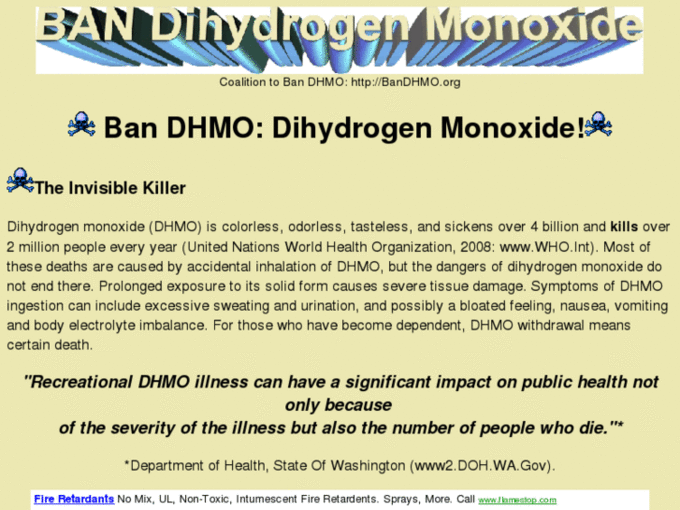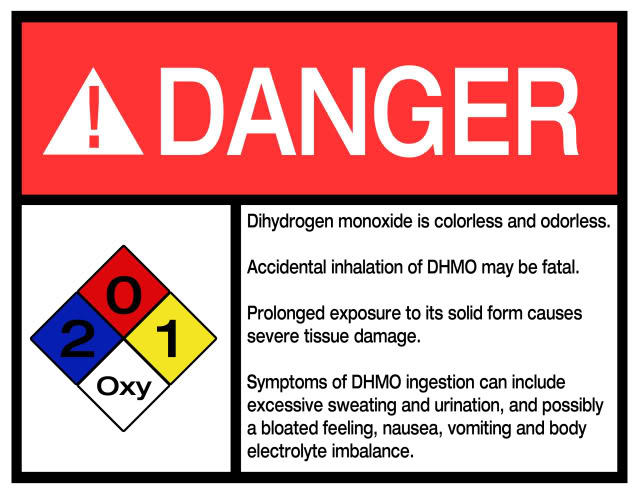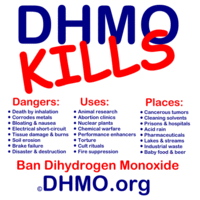Dihydrogen Monoxide Hoax
Part of a series on Pranking. [View Related Entries]


About
The dihydrogen monoxide (DHMO) is an internet hoax that is designed to convince people that "dihydrogen monoxide," a scientific name for pure water, is an extremely dangerous chemical that is present in most consumer products. Its intent is to illustrate scientific illiteracy among the general public, as well as sensationalist media reports.[2][3]
Origin
The DHMO hoax was first distributed via leaflets in the early 1990s by students at University of California Santa Cruz. They chose to use the term "dihydrogen monoxide," the molecular structure of water containing two hydrogen atoms and one oxygen atom, because of the negative connotations of the term "monoxide," which is a common name for lethal carbon monoxide gas.[2] In 1994, one of the UC Santa Cruz students Craig Jackson launched a fictitious online organization known as Coalition to Ban Dihydrogen Monoxide for dissemination in newsgroups.


The mock organization produced the following informational blurb about the dangers of DHMO, all of which are true, but were commonly misinterpreted given the scientific opaqueness of the term "dihydrogen monoxide":
Dihydrogen monoxide:
- is called "hydroxyl acid", the substance is the major component of acid rain.
- contributes to the "greenhouse effect".
- may cause severe burns.
- is fatal if inhaled.
- contributes to the erosion of our natural landscape.
- accelerates corrosion and rusting of many metals.
- may cause electrical failures and decreased effectiveness of automobile brakes.
- has been found in excised tumors of terminal cancer patients.
Despite the danger, dihydrogen monoxide is often used:
- as an industrial solvent and coolant.
- in nuclear power plants.
- in the production of Styrofoam.
- as a fire retardant.
- in many forms of cruel animal research.
- in the distribution of pesticides. Even after washing, produce remains contaminated by this chemical.
- as an additive in certain "junk-foods" and other food products.
Spread
The Coalition to Ban Dihydrogen Monoxide was reported as an internet prank for the first time in 1997 through an article titled "Internet-inspired prank lands 4 teens in hot water" published by the Pittsburgh Post-Gazette. That same year, 14-year-old Nathan Zohner from Idaho Falls, Idaho, conducted a science fair project in which he convinced the majority of his classmates to vote "yes" on a petition to ban DHMO at the school. The text of his petition was then spread around via email chain, and was reported about in the mainstream media.

Throughout the late 1990s and ealry 2000s, numerous other fictitious organizations against the use of DHMO were created for similar purposes and it became a recurring topic on conspiracy theory discussion sites,[2] most notably The Friends of Hydrogen Hydroxide[1], a foil website created by Dan Curtis Johnson in 1997 to pose as the advocacy organization of the chemical, and DHMO.org, an information resource site created by Tom Way in 1998 which included links to governmental web pages of Environmental Protection Agency and National Institutes of Health.


Since the site went live, several online petitions to ban DHMO have been submitted to governments in the English-speaking world by falsely alarmed citizens as well as by internet pranksters on April Fool's Day[2][3], including the Dutch fitness webzine Triathlonweb.nl and Canadian Member of Parliament Andrew Scheer's website on April 1st, 2010.
Search Interest
External References
[2] Wikipedia – Dihydrogen monoxide hoax
[3] Snopes – Dihydrogen monoxide
[4] Urban Dictionary – dihydrogen monoxide
[5] Netreach (via Wayback Machine) – Coalition to Ban Dihydrogen Monoxide
[6] Armory – The Friends of Hydrogen Hydroxide















